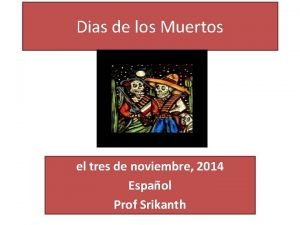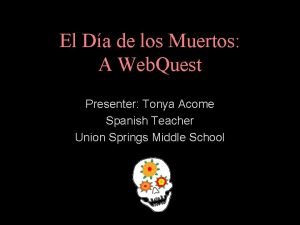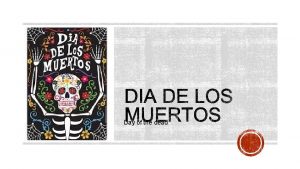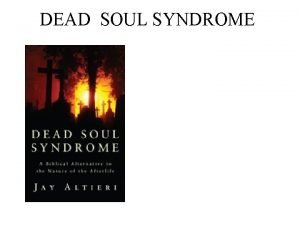Day of the dead Day of the Dead







- Slides: 7

Day of the dead Day of the Dead (Spanish: Día de los Muertos) is a holiday celebrated by many in Mexico and by some Mexican Americans living in the United States and Canada. The holiday focuses on gatherings of family and friends to pray for and remember friends and family members who have died. The celebration occurs on November 2 in connection with the Catholic holidays of All Saints' Day (November 1) and All Souls' Day (November 2). Traditions connected with the holiday include building private altars honoring the deceased using sugar skulls, marigolds, and the favorite foods and beverages of the departed and visiting graves with these as gifts.

Origins The Day of the Dead celebrations in Mexico can be traced back to the indigenous cultures. Rituals celebrating the deaths of ancestors have been observed by these civilizations perhaps for as long as 2, 500– 3, 000 years. [1] In the pre-Hispanic era, it was common to keep skulls as trophies and display them during the rituals to symbolize death and rebirth. n The festival that became the modern Day of the Dead fell in the ninth month of the Aztec calendar, about the beginning of August, and was celebrated for an entire month. The festivities were dedicated to the god[2] known as the "Lady of the Dead", corresponding to the modern Catrina. n In most regions of Mexico, November 1 honors children and infants, whereas deceased adults are honored on November 2. This is indicated by generally referring to November 1 mainly as Día de los Inocentes ("Day of the Innocents") but also as Día de los Angelitos ("Day of the Little Angels") and November 2 as Día de los Muertos or Día de los Difuntos ("Day of the Dead"). [3] n

Beliefs n n n People go to cemeteries to be with the souls of the departed and build private altars containing the favorite foods and beverages as well as photos and memorabilia of the departed. The intent is to encourage visits by the souls, so that the souls will hear the prayers and the comments of the living directed to them. Celebrations can take a humorous tone, as celebrants remember funny events and anecdotes about the departed. [3] Plans for the day are made throughout the year, including gathering the goods to be offered to the dead. During the three-day period, families usually clean and decorate graves; [2] most visit the cemeteries where their loved ones are buried and decorate their graves with ofrendas ("offerings"), which often include orange mexican marigolds (Tagetes erecta) called cempasúchitl (originally named cempoalxochitl, Nahuatl for "twenty flowers"). In modern Mexico, this name is sometimes replaced with the term Flor de Muerto ("Flower of the Dead"). These flowers are thought to attract souls of the dead to the offerings. Catrinas, one of the most popular figures of the Day of the Dead celebrations in Mexico Toys are brought for dead children (los angelitos, or "the little angels"), and bottles of tequila, mezcal or pulque or jars of atole for adults. Families will also offer trinkets or the deceased's favorite candies on the grave. Ofrendas are also put in homes, usually with foods such as candied pumpkin, pan de muerto ("bread of the dead"), and sugar skulls and beverages such as atole. The ofrendas are left out in the homes as a welcoming gesture for the deceased. [2] Some people believe the spirits of the dead eat the "spiritual essence" of the ofrendas food, so even though the celebrators eat the food after the festivities, they believe it lacks nutritional value. Pillows and blankets are left out so that the deceased can rest after their long journey. In some parts of Mexico, such as the towns of Mixquic, Pátzcuaro and Janitzio, people spend all night beside the graves of their relatives. In many places, people have picnics at the grave site as well. Public schools at all levels build altars with ofrendas, usually omitting the religious symbols. Government offices usually have at least a small altar, as this holiday is seen as important to the Mexican heritage.

pictures

pictures Day of the dead puppy

What I think n. I think that Day Of The Dead is a good way to respect your ancestors and other people’s ancestor.

Ancestors are also fun to research It’s like they have wings!!!!













